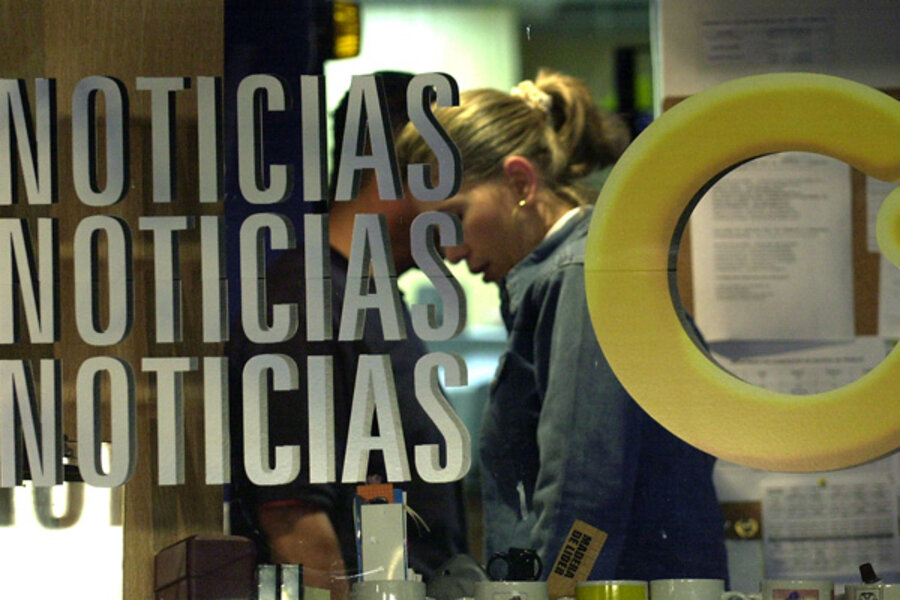Propaganda and self-censorship in Venezuelan media
Loading...
• Carolina Acosta-Alzuru is a contributor to WOLA’s blog: Venezuelan Politics and Human Rights. The views expressed are the author's own.
Venezuela will hold a presidential election in [less than] one month. Though the media are key actors in any political campaign, they are even more so in short campaigns such as the one leading up to April 14th. Analysis of Venezuela’s media landscape usually hovers around two poles:
Communication and information rights “have been under fire during the Chávez Era” (Cañizález, 2009).
“The vast majority of Venezuela’s media […] are constitutionally protected, uncensored, and dominated by the opposition” (Weisbrot & McChesney, 2007).
My comments here focus on television, a mass medium of tremendous importance in Venezuelan culture and everyday life. This is the television landscape in terms of average daily shares, i.e. the percentage of television sets in use tuned to each network or group of networks:
Venevision+Televen: 40-45 percent.
Cable: 30-35 percent.
State channels: 8-10 percent.
Globovisión: 4.5-6 percent.
Others (as defined by A.G.B.): 8-10 percent.
Oppositional network Gobovision’s mere existence serves as the perfect example to counter those who criticize compromised speech and press freedoms in Venezuela. But given its small share, Globovisión is not nearly as damaging to the government as many would like to think, or as the government conveniently contends. Moreover, while Globovisión provides conversation pieces for antichavistas it does not reach many of those Venezuelans that the opposition would like to convince of an alternative to chavismo or now, “madurismo.”
Ten years ago, analyses of Venezuelan television based on ownership patterns were telling of polarized content. Today, such assessments are limited and misleading. That the sum of state television outlets has a share of only 8-10 percent is not the whole story. Why? Because assuming that the private media are oppositional or that they give voice to dissidence is simply wrong.
It is necessary to ask: How much of the content presented by the two privately owned networks, that together have a share of 40-45 percent, is oppositional to the government? After the enactment of the 2005 media content law (Ley Resorte) and 2007 non-renewal of RCTV’s license, what content do Televen and Venevision broadcast out of fear? What do they not broadcast also out of fear?
Self-censorship, the Ley Resorte’s ultimate effect in the post-RCTV era has had chilling results and is an undeniable element in many Venezuelan media outlets. Unlike censorship, which is usually evident, self-censorship is difficult to trace. In my research on Venezuelan telenovelas, I have been able to witness and document the increasing presence of self-censorship (Acosta-Alzuru, C. in press. “Melodrama, reality and crisis: The government-media relationship in Hugo Chávez’s Bolivarian Revolution.” International Journal of Cultural Studies). In many cases, self-censorship was more restrictive than the Ley Resorte itself. Self-censorship has become one of the two main survival strategies for the remaining television networks in Venezuela. The other one is strict obedience. In my research I have not seen a shred of resistance when these outlets receive an “exhortation” from the government to pull a show or ban a voice from being aired.
These networks argue that as entertainment producers they should stay away from the political fray. Government opponents call their behavior opportunistic and underscore television’s responsibility to inform. In Venevisión’s case, the contrast between 2003-2004, when it broadcast Cosita Rica (a telenovela that mirrored the rocky path to the presidential recall referendum and whose antagonist was a metaphor of President Chávez) and the network’s current strict self-censorship says volumes about the evolution of the media situation in Venezuela in the last decade.
In sum, to understand television’s landscape and how it contributes to the uneven political terrain in Venezuela, it is necessary to analyze more than ownership patterns. Content (presences and absences), shares, the use of mandatory cadenas by the government, and the presence of voluntary cadenas in major outlets are essential to understand the inextricable links between Venezuela’s political and media situations.
With state television in propaganda mode and the most important private television outlets in survival mode, what will be the future of Venezuela’s access to a plurality of voices in the media?
- Carolina Acosta-Alzuru @caa2410 is Associate Professor in the Grady College of Journalism and Mass Communication at the University of Georgia. She is the author of Venezuela es una Telenovela (Alfa 2007).







